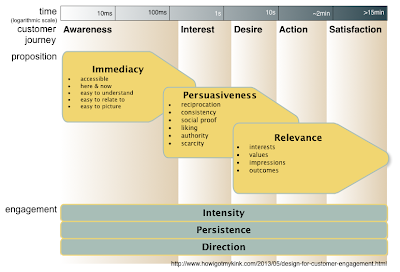35 Point Design for Engagement Checklist
Rules of Engagement
This is a list of 35 guidelines, listed in the order of the customer journey, from the Design for Customer Engagement series of posts. You might also like the related post on customer relationships. |
| terms of engagement |
Right Now (read more)
- Optimize the entire customer experience for speed; not just the user interface, but everything from a first awareness of your proposition to fulfillment. (What is a proposition? See this post.)
Right Here (read more)
- Design for mobile first, but not mobile only.
- Make design elements large.
- Place important elements where people are already looking (e.g., top of page, top of lists).
Easy to Understand (read more)
- Solve a problem the user already knows they have.
- Focus every element of the design on making that single, clear proposition available.
- Achieve simplicity through minimalism. Take something out.
Easy To Relate To (read more)
- Use visual design and written copy to reflect an emotional state, aligning with that of your audience.
Easy to picture (read more)
- Show, don't tell, the value of your proposition.
- Use imagery and concrete descriptions in written copy.
- Frame your communication as a vivid story.
Accessible (read more)
- Design for the context in which your audience will experience your proposition, considering physical, cognitive, and any other limitations that might make your proposition less available to your audience (For example: time pressure, background noise, poor eyesight, low resolution screens…).
- Design for accessibility.
Reciprocation (read more)
- Give before asking anything from your audience (e.g. a free gift, information, or service).
- Personalize your gift or service for the recipient.
Consistency (read more)
- Ask your customer for a small, easily agreeable, action before a proceeding to a larger request.
- Encourage and facilitate your customer to express voluntary, active, and public commitment to your proposition (e.g., social endorsements, reviews, tweets).
Social Proof (read more)
- Give evidence that your proposition is popular.
- Show that your customer's peers trust the proposition.
Liking (read more)
- Connect your proposition to something or someone your customer already likes.
- Reflect characteristics of your customer, such as physical traits, gender, age, race, religion, nationality, interests, etc.
Authority (read more)
- Show the basis of your authority, including expertise and recognized accomplishments.
- Show stamps of approval or certifications from recognized impartial authorities.
Scarcity (read more)
- Frame your proposition to highlight what your audience stands to lose if they don't accept your offer.
- Emphasize the unique elements of your proposition.
- Use limits on availability to create exclusivity, for example, stock or time limits, private access, distinctive styling, or new-to-market functionality.
Value Relevance (read more)
- Project a set of well-defined and differentiated values; imprecise or generic values serve no purpose.
- Don't be afraid of a polarizing proposition. Nobody values insipid.
Impression Relevance (read more)
- Highlight the power of your proposition to impress friends and frighten rivals.
- Use strong visual design to create and communicate status appeal.
Outcome Relevance (read more)
- Connect your proposition to your customer's goals.
- Focus every aspect of the design on the outcome rather than the designed product.
Intensity (read more)
- Create at least one intense moment of surprise, delight, intrigue or amusement for your user.
- Address your customer personally.
- Add performance metrics and displays to foster a sense of accountability.
Please share this post. Please leave a comment, I'll reply. Thanks for reading!
If your interests extend to theory and philosophy, please check out my other blog.


Great and impressive article.!! Got to learn and know more about designing.
ReplyDeleteschool websites